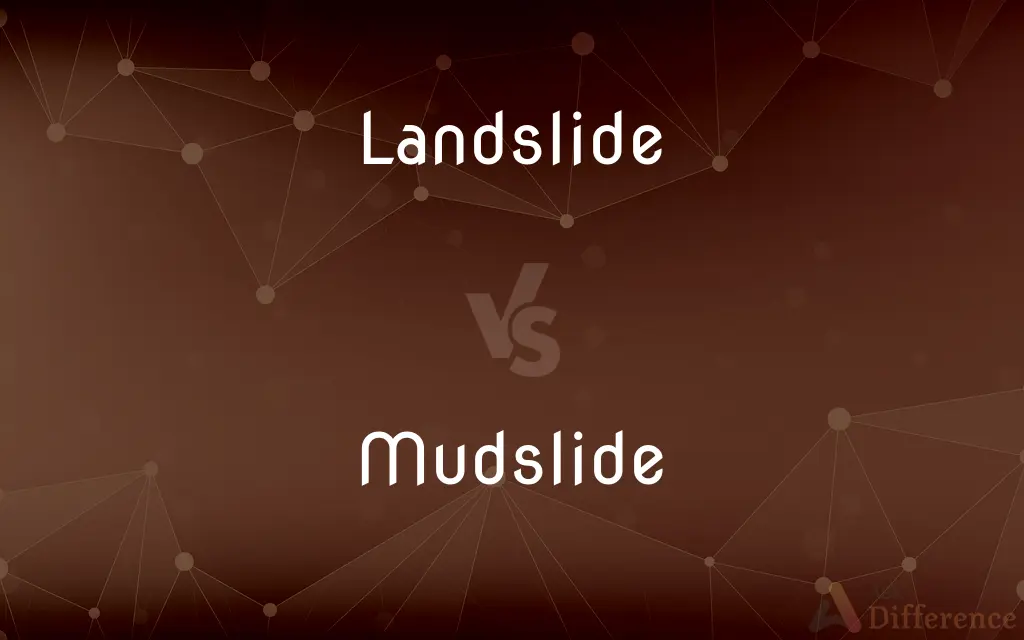Landslide vs. Mudslide — What's the Difference?
By Fiza Rafique & Maham Liaqat — Updated on April 29, 2024
Landslides involve the movement of rock, earth, or debris down a slope, due to gravity, while mudslides specifically involve mud and are often triggered by rainfall or water saturation.

Difference Between Landslide and Mudslide
Table of Contents
ADVERTISEMENT
Key Differences
A landslide is a geological phenomenon where soil, rocks, and other debris slide down a slope, typically influenced by factors like erosion, earthquakes, or volcanic activity. Whereas, a mudslide is a type of landslide where the material involved is primarily mud, often initiated by heavy rainfall or rapid snowmelt.
Landslides can occur on any sloped surface and often impact larger areas due to the volume and type of materials involved. On the other hand, mudslides are usually more localized but can move with great speed due to the lubricating effect of the water content.
The risk factors for landslides include deforestation, improper land use, and seismic activity, which destabilize slopes over time. In contrast, mudslides are particularly associated with specific weather conditions that saturate the soil with water, making it unstable.
Prevention measures for landslides often involve engineering solutions like retaining walls and proper drainage systems to stabilize slopes. Mudslides, however, also require careful monitoring of rainfall and quick response plans to evacuate areas at risk during intense precipitation.
The aftermath of a landslide might involve reconstructing damaged infrastructure and rehabilitating landscapes, which can be extensive and costly. Mudslides, while also destructive, typically result in more immediate but less widespread damage, focusing recovery efforts on removing mud deposits and restoring waterways.
ADVERTISEMENT
Comparison Chart
Definition
Movement of rock, earth, or debris down a slope.
Movement of mud down a slope, often saturated with water.
Causes
Erosion, earthquakes, volcanic activity, human activity.
Heavy rainfall, rapid snowmelt, water saturation.
Materials
Rock, earth, debris.
Primarily mud, with some debris.
Speed
Variable, can be rapid or slow.
Typically rapid due to the lubricating effect of water.
Prevention
Engineering controls, land use planning, reforestation.
Monitoring rainfall, proper drainage, quick evacuation plans.
Compare with Definitions
Landslide
Requires preventive measures like slope stabilization.
The town implemented a landslide prevention program.
Mudslide
A specific type of landslide involving mud.
The mudslide swept through the village last night.
Landslide
A geological movement of soil and rock down a slope.
The landslide blocked the main road into town.
Mudslide
Commonly triggered by intense rainfall.
Days of heavy rain culminated in a dangerous mudslide.
Landslide
Involves various materials including rocks and earth.
The landslide debris consisted of boulders and mud.
Mudslide
Moves quickly due to water saturation.
The rapid mudslide trapped vehicles on the highway.
Landslide
Often triggered by natural processes or human activity.
After the earthquake, a landslide caused further damage.
Mudslide
Often impacts smaller, more localized areas.
The mudslide covered the backyard in thick mud.
Landslide
Can cause extensive area damage.
The landslide affected several acres of the national park.
Mudslide
Can be mitigated by monitoring weather conditions.
Authorities issued a mudslide warning after the storm forecast.
Landslide
The term landslide or, less frequently, landslip, refers to several forms of mass wasting that may include a wide range of ground movements, such as rockfalls, deep-seated slope failures, mudflows, and debris flows. Landslides occur in a variety of environments, characterized by either steep or gentle slope gradients, from mountain ranges to coastal cliffs or even underwater, in which case they are called submarine landslides.
Mudslide
A mudflow, especially a slow-moving one.
Landslide
The downward sliding of a relatively dry mass of earth and rock.
Mudslide
A sweet cocktail made with a whiskey-based liqueur blended with cream, a coffee liqueur, and sometimes vodka, served over ice.
Landslide
The mass that slides. Also called landslip.
Mudslide
A geological event in which viscous mud flows down an incline.
Landslide
A percentage of votes greatly exceeding the required margin of victory.
Mudslide
A mixed drink consisting of vodka, Kahlúa and Baileys.
Landslide
An election that sweeps a party or candidate into office.
Mudslide
A landslide of mud
Landslide
A great victory.
Landslide
A natural disaster that involves the breakup and downhill flow of rock, mud, water and anything caught in the path.
Landslide
A vote won by a wide or overwhelming majority.
The candidate won by a landslide.
Landslide
To undergo a landslide.
Landslide
The slipping down of a mass of land from a mountain, hill, etc.
Landslide
The land which slips down.
Landslide
An election victory in which the winning candidate receives a substantial majority of the votes, usually meaning at least ten per cent more than any opposing candidate.
Landslide
Any overwhelming victory.
Landslide
An overwhelming electoral victory;
Roosevelt defeated Hoover in a landslide
Landslide
A slide of a large mass of dirt and rock down a mountain or cliff
Common Curiosities
What is a landslide?
A landslide is a downward movement of rock and soil down a slope.
What causes a mudslide?
Mudslides are mainly caused by water saturation from heavy rains or snowmelt.
What is a mudslide?
A mudslide is a type of landslide that specifically involves the movement of mud.
What causes a landslide?
Landslides can be caused by erosion, seismic activity, or human interference.
How do landslides differ from mudslides?
Landslides can involve a variety of materials, while mudslides specifically involve mud.
What are the effects of a landslide?
Landslides can cause extensive environmental and infrastructural damage.
What areas are prone to landslides?
Areas with unstable slopes, such as mountainous regions, are prone to landslides.
Can landslides be predicted?
While difficult, some potential landslides can be predicted through geological surveys.
Can mudslides be predicted?
Monitoring weather and soil conditions can help predict potential mudslides.
How can landslides be prevented?
Engineering efforts like retaining walls and reforestation can help prevent landslides.
Who is at risk from landslides?
People living near steep slopes, especially in seismic zones, are at risk.
What are the effects of a mudslide?
Mudslides typically cause rapid, localized damage and can block roads and waterways.
How can mudslides be prevented?
Proper drainage and quick responses to heavy rainfall are key to preventing mudslides.
Who is at risk from mudslides?
Communities located in or below steep, water-laden slopes face the highest risk from mudslides.
What areas are prone to mudslides?
Regions with frequent heavy rainfall and steep slopes are more susceptible to mudslides.
Share Your Discovery

Previous Comparison
Barge vs. Scow
Next Comparison
Kohl vs. EyelinerAuthor Spotlight
Written by
Fiza RafiqueFiza Rafique is a skilled content writer at AskDifference.com, where she meticulously refines and enhances written pieces. Drawing from her vast editorial expertise, Fiza ensures clarity, accuracy, and precision in every article. Passionate about language, she continually seeks to elevate the quality of content for readers worldwide.
Co-written by
Maham Liaqat















































